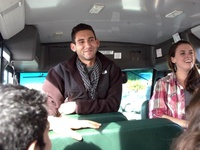Lauren A. Williams ’14 remembered her first “positive no” while campaigning for defeated Connecticut Senate candidate Linda McMahon.
“I’m never going to vote for Linda McMahon,” said the woman opening the door. But although she didn’t share their Republican views, she still offered to take Williams and her canvassing partner to her next-door neighbor’s house because she was impressed that the pair was “doing their civic duty.”
In preparation for the midterm elections, Harvard students from both sides of the political spectrum spent weeks hitting the streets and manning the phones in support of both candidates and specific issues.
“A CAMPAIGN ORGANIZATION”
On Saturday morning, a group of about 30 students huddled outside Johnston Gate at 10 a.m., drinking coffee and eating pastries while they waited to get on a yellow school bus that would drive them to New Hampshire.
After Harvard College Democrats President Jason Q. Berkenfeld ’11 and Campaigns Director Evelyn R. Wenger ’11 successfully corralled everyone onto the bus, Berkenfeld gave a quick pep talk about the necessity of grassroots canvassing.
Every weekend about 25 to 30 volunteers devoted their Saturdays to campaigning, according to Berkenfeld: “The Harvard College Democrats are really a campaign organization, and we are at our finest when we are devoting our efforts to campaigning specifically,” Berkenfeld said.
About an hour later, about 15 minutes from campaign headquarters, Wenger stood up to explain the views of the candidates for whom the group was canvassing—defeated Paul Hodes for Senate, defeated Carol Shea-Porter for Congress, and reelected John Lynch for governor—and the importance of the races.
After getting off the bus, the group separated into pairs and headed to campaign headquarters for training and route assignments. At 1 p.m., Allison Gofman ’14 and Gary D. J. Gerbrandt ’14, maps and flyers in hand, were ready to canvass.
The campaign had given the pair a lists of houses to go to, where they woul talk to voters and remind them to vote on Tuesday. These lists also included voting records, so Gofman and Gerbrandt knew how many times each voter had voted in the past three elections.
Early on in their campaigning, Gofman and Gerbrandt received a positive reception from a voter who had voted in all three of the past elections. “Tell your friends to vote,” Gofman reminded her.
“I’ll tell my friends to vote,” the woman said. “Well, most of them. The Republicans, I’ll tell to stay home.”
If the voter was not home and had voted three out of three times or zero out of three times, Gofman and Gerbrandt were supposed to mark “NH”—meaning “not home”—on their sheet and continue. The voters who had not voted in the past elections would be visited and called again by the campaign to ensure that they would vote.
If the voter was not home and had only voted once or twice in the past three elections, Gofman and Gerbrandt left campaign brochures, marked “NH” on their sheet, and continued.
During his multiple trips to Manchester and his one trip to Exeter, N.H., Gerbrandt gained a lot of experience about where to leave pamphlets—never in mailboxes because it is a federal offense—and learned that canvassing during a Patriots game is rarely successful.
Read more in News
Student Groups View Election ResultsRecommended Articles
-
Tuesday Market Ends for SeasonThe Harvard Farmers’ Market concluded its four-month season in front of the Science Center yesterday with a tour of the ...
-
 Not your Average Candidate
Not your Average Candidate -
 College Republicans Go Door-to-Door
College Republicans Go Door-to-Door -
Harvard Democrats Face Choice: Massachusetts or New HampshireA razor thin lead for President Barack Obama in New Hampshire and a Massachusetts Senate race that is too close to call have Harvard College politicos racing to Nov. 6, forced to decide where to invest their diminishing time and resources.
















